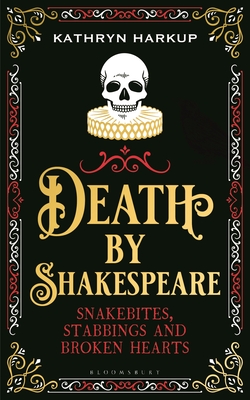You are here
Back to topDeath By Shakespeare: Snakebites, Stabbings and Broken Hearts (Hardcover)
Description
An in-depth look at the science behind the creative methods Shakespeare used to kill off his characters.
In Death By Shakespeare, Kathryn Harkup, best-selling author of A is for Arsenic and expert on the more gruesome side of science, turns her expertise to William Shakespeare and the creative methods he used to kill off his characters. Is death by snakebite really as serene as Cleopatra made it seem? How did Juliet appear dead for 72 hours only to be revived in perfect health? Can you really kill someone by pouring poison in their ear? How long would it take before Lady Macbeth died from lack of sleep? Harkup investigates what actual events may have inspired Shakespeare, what the accepted scientific knowledge of the time was, and how Elizabethan audiences would have responded to these death scenes. Death by Shakespeare reveals this and more in a rollercoaster of Elizabethan carnage, poison, swordplay and bloodshed, with an occasional death by bear-mauling for good measure.
In the Bard's day death was a part of everyday life. Plague, pestilence and public executions were a common occurrence, and the chances of seeing a dead or dying body on the way home from the theater was a fairly likely scenario. Death is one of the major themes that reoccurs constantly throughout Shakespeare's canon, and he certainly didn't shy away from portraying the bloody reality of death on the stage. He didn't have to invent gruesome or novel ways to kill off his characters when everyday experience provided plenty of inspiration.
Shakespeare's era was also a time of huge scientific advance. The human body, its construction and how it was affected by disease came under scrutiny, overturning more than a thousand years of received Greek wisdom, and Shakespeare himself hinted at these new scientific discoveries and medical advances in his writing, such as circulation of the blood and treatments for syphilis.
Shakespeare found dozens of different ways to kill off his characters, and audiences today still enjoy the same reactions--shock, sadness, fear--that they did over 400 years ago when these plays were first performed. But how realistic are these deaths, and did Shakespeare have the science to back them up?
About the Author
Kathryn Harkup is a chemist and author. Kathryn completed a doctorate on her favorite chemicals, phosphines, and went on to further postdoctoral research before realizing that talking, writing and demonstrating science appealed a bit more than hours slaving over a hot fume-hood. She currently writes a monthly poison blog for the Guardian and gives regular public talks on the disgusting and dangerous side of science. Kathryn's first book was the international best-seller A is for Arsenic, which was shortlisted for both the International Macavity Award and the BMA Book Award.
Praise For…
“[Harkup] speculates about what Shakespeare knew about causes of death; like other contemporary playwrights, he did know that audiences loved violence. A brisk, informative, and startling look at Shakespeare.” - Kirkus
“Fans of the Bard are sure to devour this, but even those with only a passing familiarity with Shakespeare’s oeuvre will find Harkup’s survey tough to resist.” - Publishers Weekly STARRED review
“The research is concrete, and the writing is infused with sly humor. Harkup serves a delectable stew of history, science, and wit that is sure to sate the appetite of any Anglophile.” - Booklist
“Harkup leaves no stone unturned in her immensely thorough and compelling distillation of the Bard's work, Death by Shakespeare...Her narrative will attract and intrigue readers who appreciate the macabre, eager for the enriching wisdom offered by two masters in their fields. A fascinating, thorough examination and scientific analysis of notable deaths that pervade the stage works of William Shakespeare.” - Shelf Awareness
“For fans of the Bard, Death by Shakespeare: Snakebites, Stabbings, and Broken Hearts is the book they didn’t know they always wanted to read.” - BookPage
“The author of A Is for Arsenic and Making the Monster: The Science Behind Mary Shelley’s Frankenstein continues her macabre cultural musings with an immensely readable roundup of Shakespearean death.” - Smithsonian Magazine
“Light enough to be a quick read for fun but hefty enough to educate, this is a book that any student would be happy to study for a class, and it’s a solid addition to any nonfiction or Shakespearean fan’s collection. Yet again, Harkup has delivered a satisfying, sterling examination of an iconic figure’s literary contributions to history.” - Criminal Element
"Well-written and intriguing, the book provides a rich behind-the-scenes look at science and historical fact, using the focus on death to deepen understanding of Shakespeare’s life and work. Hereby hangs a tale." - Historical Novel Society
“Harkup dives into Shakespeare’s deadly times with an eye for detail and anecdote and a scientist’s detachment from the gruesome details of the fate in store for so many in the days before antibiotics and vaccines...Death By Shakespeare is a macabre but fascinating read, rich in historical context, scientific insight, and intriguing asides.” - Ellery Queen's Mystery Magazine
“Harkup’s enjoyable and informative survey presents this somatic Shakespeare for the Horrible Histories generation” - Times Literary Supplement
“Were I a school-teacher introducing phone-addicted teens to Macbeth or Romeo and Juliet, I'd go in big on Shakespeare's 'violent delights'.” - Daily Mail
“Serious scholarship meets horrid histories. Kathryn Harkup located Death by Shakespeare within the contexts of science and medicine, health and safety, crime and punishment, and in the process gives us tour de force descriptions of Juliet's deep coma, Cleopatra's asp, Ophelia's drowning and the carnage at Agincourt, among other celebrated exits. It's a good read – never morbid, and full of insights into the Tudor way of death and how far we've come” - Professor Sir Christopher Frayling, cultural historian, writer and broadcaster
